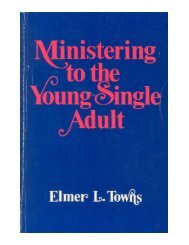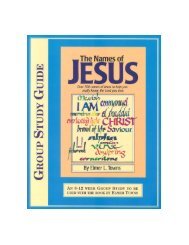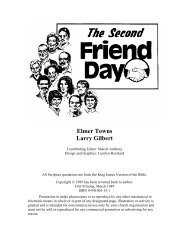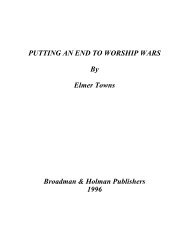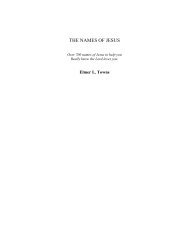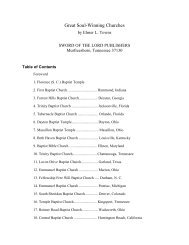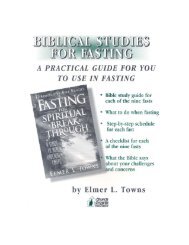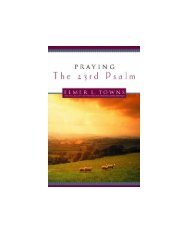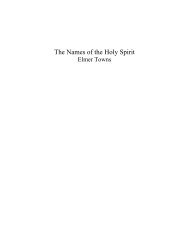- Page 2 and 3:
A Journey Through The Old Testament
- Page 4 and 5:
43. ELISHA: The Prophet of Twice th
- Page 6 and 7:
matter of fact, nothing is eternal
- Page 8 and 9:
Be like the Most High The title “
- Page 10 and 11:
TWO ADAM: The Man Who Had Everythin
- Page 12 and 13:
Individuals normally fall into sin
- Page 14 and 15:
Christ whom Paul calls “the last
- Page 16 and 17:
abandon Cain. Rather the Lord came
- Page 18 and 19:
When Cain determined to abandon the
- Page 20 and 21:
would be that son, Noah, who sailed
- Page 22 and 23:
8 The Flood which followed the ente
- Page 24 and 25:
always leads to judgment. But Noah,
- Page 26 and 27:
happened in the tent is not certain
- Page 28 and 29:
at this time that the Americas and
- Page 30 and 31:
Though the Scripture explains, “N
- Page 32 and 33: The first call of Abram involved th
- Page 34 and 35: Damascus (cf. 15:2-3). When Abram a
- Page 36 and 37: SEVEN ABRAHAM: Lapse of Faith: Reas
- Page 38 and 39: their root in this period when Abra
- Page 40 and 41: comes to God must believe that He i
- Page 42 and 43: (Gen. 13:8, literal translation). A
- Page 44 and 45: greater blessing. The man of faith
- Page 46 and 47: mothers, a practice which may have
- Page 48 and 49: Melchizedek is described as the pri
- Page 50 and 51: tion of righteousness. Also, the co
- Page 52 and 53: Israel, consistently tried to destr
- Page 54 and 55: HAGAR AND SARAI (Gen. 16:4-6) (2080
- Page 56 and 57: the natural carnal instincts of hum
- Page 58 and 59: eflects a change in Abram which end
- Page 60 and 61: appreciation. When God promised Abr
- Page 62 and 63: desert period in Abraham’s life w
- Page 64 and 65: focus on the problems and soon come
- Page 66 and 67: FOURTEEN LOT: The Destruction of So
- Page 68 and 69: The Scriptures record, “The sun h
- Page 70 and 71: of the highest costs associated wit
- Page 72 and 73: must be viewed as intentional mocki
- Page 74 and 75: 6, 9). Second, we are to reckon or
- Page 76 and 77: “offer” and the name of the sac
- Page 78 and 79: forward to that distant day when on
- Page 80 and 81: faith commitment to God is more tha
- Page 84 and 85: THE SERVANT AND THE FATHER (Gen. 24
- Page 86 and 87: Rebekah proved herself to be a hard
- Page 88 and 89: een meditating about his flocks, bu
- Page 90 and 91: let the children separate them and
- Page 92 and 93: Though Isaac left the city, he did
- Page 94 and 95: similar symptoms of aging in his ow
- Page 96 and 97: house of God.” Bethel would be mo
- Page 98 and 99: a curse. It might be paraphrased to
- Page 100 and 101: The Dreamer (Genesis 37:1-50; 26) T
- Page 102 and 103: JOSEPH AS A SLAVE IN EGYPT (Gen. 39
- Page 104 and 105: plenty, God continued to bless Jose
- Page 106 and 107: Some critics have disputed the reli
- Page 108 and 109: high, and a man who had a vital rel
- Page 110 and 111: scarring and mutilation may be caus
- Page 112 and 113: God, Eliphaz was instructed, “Tak
- Page 114 and 115: First, Jochebed wove a basket out o
- Page 116 and 117: were a phenomenon which challenged
- Page 118 and 119: oasis Marah which means “bitter
- Page 120 and 121: The giving of the Law to Israel cam
- Page 122 and 123: While Moses and Joshua ascended the
- Page 124 and 125: A second area of interest in the Bo
- Page 126 and 127: ecause of the same kind of unbelief
- Page 128 and 129: Israel. “And the earth opened its
- Page 130 and 131: contains a chapter which the rabbis
- Page 132 and 133:
Learning about a sustained confiden
- Page 134 and 135:
Christ, John the Baptist chose seve
- Page 136 and 137:
described as a savior meeting the S
- Page 138 and 139:
JOSHUA: From Victory to Victory (Jo
- Page 140 and 141:
THE NORTHERN CAMPAIGN (Josh. 11:1-1
- Page 142 and 143:
TWENTY-EIGHT JUDGES: Othniel, Ehud,
- Page 144 and 145:
attlefield or in spiritual realms.
- Page 146 and 147:
DEBORAH AND BARAK AND THE DEFEAT OF
- Page 148 and 149:
Lord is with us” (v. 13), suggest
- Page 150 and 151:
GIDEON: THE READY CRUSADER (Jud. 7:
- Page 152 and 153:
of action in that city, it was he w
- Page 154 and 155:
ead during their Exodus from Egypt
- Page 156 and 157:
LOVE’S REQUEST (Ruth 3:1-18) Naom
- Page 158 and 159:
worshipers. Because of the importan
- Page 160 and 161:
paternity could not always be estab
- Page 162 and 163:
Jephthah’s problems were not over
- Page 164 and 165:
THE WIFE OF MANOAH (Jud. 13:1-25) (
- Page 166 and 167:
decaying carcass of the lion as a h
- Page 168 and 169:
Delilah sought to learn the secret
- Page 170 and 171:
With the compromising Levite and Mi
- Page 172 and 173:
attlefront would raise the spirits
- Page 174 and 175:
“Then she made a vow and said, `O
- Page 176 and 177:
the voice again, he was to remain w
- Page 178 and 179:
territory, to Beth Shemesh, then He
- Page 180 and 181:
when they would cry out to God beca
- Page 182 and 183:
finding the lost asses; however, hi
- Page 184 and 185:
a battle and the ensuing loss of li
- Page 186 and 187:
Philistines disarmed the nation so
- Page 188 and 189:
to mourn until God intervened and s
- Page 190 and 191:
valley of Elah. “I defy the armie
- Page 192 and 193:
Saul began to view David as a perso
- Page 194 and 195:
Samuel were staying, he too began p
- Page 196 and 197:
dead. Every legitimate means of dis
- Page 198 and 199:
On the death of Saul, David was the
- Page 200 and 201:
elieved Joab could be trusted. He p
- Page 202 and 203:
that place until the dedication of
- Page 204 and 205:
his own bed in Jerusalem rather tha
- Page 206 and 207:
David himself had called for the st
- Page 208 and 209:
When his cousin Jonadab probed Amno
- Page 210 and 211:
attlefields against Absalom, the ot
- Page 212 and 213:
enemies of Israel during his reign.
- Page 214 and 215:
agreed with the settlement, the oth
- Page 216 and 217:
THE WEALTH OF SOLOMON (1 Kings 9:10
- Page 218 and 219:
Though most of the book contains an
- Page 220 and 221:
JEROBOAM AND REHOBOAM: The Division
- Page 222 and 223:
chance of succeeding, and now it wa
- Page 224 and 225:
It took the serious illness of his
- Page 226 and 227:
Kingdom of Israel. The political tu
- Page 228 and 229:
God. This apostate dynasty would le
- Page 230 and 231:
anticipatory sense as the next dyna
- Page 232 and 233:
The Man of Like Passion and Power (
- Page 234 and 235:
again appear in the sky and the ear
- Page 236 and 237:
times before his servant saw a smal
- Page 238 and 239:
for the king. “Because you have l
- Page 240 and 241:
Rather than call for the surrender
- Page 242 and 243:
On another occasion, Elisha raised
- Page 244 and 245:
“And it all happened after this t
- Page 246 and 247:
In a strange chain of events, while
- Page 248 and 249:
different pattern of ministry in se
- Page 250 and 251:
that Israel’s captivity really be
- Page 252 and 253:
epentance. Even before the Northern
- Page 254 and 255:
you shall go up to the house of the
- Page 256 and 257:
tree with a saw, cutting the prophe
- Page 258 and 259:
FORTY-SIX JEREMIAH: The Collapsing
- Page 260 and 261:
(597-586 B.C.) Nebuchadnezzar appoi
- Page 262 and 263:
transferred by God from the priestl
- Page 264 and 265:
Ezekiel did not believe Israel’s
- Page 266 and 267:
prepared according to regulations.
- Page 268 and 269:
6:10; 7:12, 21; Neh. 1:5; 2:4; Ps.
- Page 270 and 271:
may have often heard her father spe
- Page 272 and 273:
Cyrus was an unusual choice for God
- Page 274 and 275:
temple, the Samaritans intimidated
- Page 276 and 277:
For the Jews who chose not to retur
- Page 278 and 279:
that had been thwarted. When he hea
- Page 280 and 281:
project would take. Soon Nehemiah h
- Page 282 and 283:
Jerusalem had been more than physic
- Page 284 and 285:
Antiochus Epiphanes was predicted i



